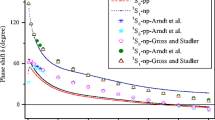Summary
A discussion is given of some phenomenological aspects of Σ-nucleon scattering. It is noted that with Σ+ beams likely to be available in the near future, triple scattering experiments are only slightly more difficult than single scattering experiments. A method of determining separately1 S and3 S phase shifts at low energies is noted. A discussion is given of the qualitative features of low-energy Σ-nucleon scattering to be expected if one or the other of the global symmetry modelsG πΣ≈±G πN is valid, and possibilities of distinguishing between the two cases are examined, utilizing the Mandelstam representation for the scattering amplitude, some consequences of which are derived in the appendix. In particular, the analytic properties of the partial wave amplitudes are deduced; it is found that owing to the unequal masses of Σ and nucleon, the singularities of the partial wave amplitudes do not all lie on the real axis in the complex plane of the energy variable.
Riassunto
Si presenta una discussione di alcuni aspetti fenomenologici dello scattering dei nucleoni Σ. Si nota che con raggi Σ+, che verosimilmente saranno disponibili nel prossimo futuro, esperimenti di scattering triplo sono solo di poco più difficili degli esperimenti di scattering semplice. Si nota un metodo per determinare separatamente gli spostamenti di fase1 S e3 S. Si presenta una discussione delle caratteristiche qualitative dello scattering a bassa energia Σ-nucleone, che si devono avere se l’uno o l’altro dei modelli di simmetria globaleG πΣ≈±G πN è valido, e si esamina la possibilità di distinguere fra i due casi, utilizzando la rappresentazione di Mandelstam per l’ampiezza di scattering, alcune conseguenze della quale sono dedotte in appendice. In particolare si deducono le proprietà analitiche delle ampiezze d’onda parziali; si trova che, per la ineguaglianza delle masse del Σ e del nucleone, le singolarità delle ampiezze d’onda parziali non giacciono tutte sull’asse reale nel piano complesso della variabile dell’energia.
Similar content being viewed by others
References
M. Gell-Mann:Phys. Rev.,106, 1296 (1957).
D. C. Peaslee:Phys. Rev.,117, 873 (1960).
These data have been summarized byR. H. Dalitz:Proc. of the Kiev Conference on High-Energy Physics (1959).
D. B. Lichtenberg andM. Ross:Phys. Rev.,107, 1714 (1957);F. Ferrari andL. Fonda:Nuovo Cimento,9, 842 (1958);R. H. Dalitz andB. W. Downs:Phys. Rev.,111, 967 (1958); andM. T. Vaughn:Purdue University Ph. D. thesis (1960).
R. L. Cool, B. Cork, J. W. Cronin andW. A. Wenzel:Phys. Rev.,114, 912 (1959).
Triple scattering is fully discussed byL. Wolfenstein:Ann. Rev. Nucl. Sci.,6, 43 (1956).
This decomposition has been given previously by many authors; see, for example,M. Goldberger, Y. Nambu andR. Oehme:Ann. Phys.,2, 226 (1957), which contains references to earlier work.
Wolfenstein (7) has given a general discussion of the relation of observables to the transition matrix.
The possibility of distinguishing singlet scattering and triplet scattering in the low-energy limit by measurement ofQ(θ) has been noted also byGardner andWelton:Phys. Rev. Lett.,3, 281 (1959).
Several authors have discussed the possible existence of such a bound state: seeD. Lichtenberg andM. Ross:Phys. Rev.,107, 1714 (1957);F. Ferrari andL. Fonda:Nuovo Cimento,6, 1027 (1957);M. Vaughn:Bull. Am. Phys. Soc.,2, 353 (1957); andG. A. Snow:Phys. Rev.,110, 1192 (1958).
J. M. Blatt andJ. D. Jackson:Phys. Rev.,76, 18 (1949).
M. Cini, S. Fubini andG. Stanghellini:Phys. Rev.,114, 1633 (1959).
S. Mandelstam:Phys. Rev.,112, 1344 (1958).
H. P. Noyes andD. Y. Wong:Phys. Rev. Lett.,3, 191 (1959).
P. Cziffra, M. MacGregor, M. Moravcsik andH. Stapp:Phys. Rev.,114, 880 (1959);M. MacGregor, M. Moravcsik andH. Stapp:Phys. Rev.,116, 1248 (1959)
These are essentially theG j(ν, Q 2) of reference (8), except that there are now six invariants instead of five.
The author is indebted toA. Klein for suggesting this starting point.
S. MacDowell:Phys. Rev.,116, 774 (1959).
H. P. Noyes: private communication. We are indebted to Dr.Noyes for a discussion of this point.
Author information
Authors and Affiliations
Additional information
Based on part of a Ph. D. thesis submitted to Purdue University.
Supported in part by the U. S. Air Force Office of Scientific Research.
Rights and permissions
About this article
Cite this article
Vaughn, M.T. Phenomenology of Σ-nucleon scattering. Nuovo Cim 18 (Suppl 1), 178–190 (1960). https://doi.org/10.1007/BF02726048
Received:
Published:
Issue Date:
DOI: https://doi.org/10.1007/BF02726048




